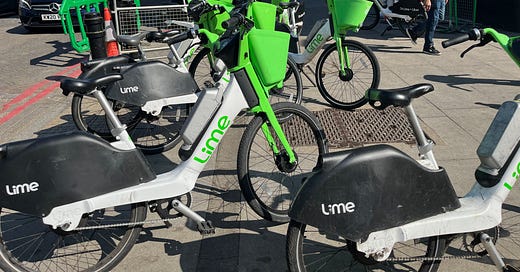One weird trick to get a free ride in London
The 'click-clack of anti-capitalism' is the soundtrack to the London summer
If you’ve been in London this summer, you’ve surely heard it: a loud, pervasive clacking as a Lime bike goes by.
That sound, also called the “click clack of anti-capitalism,” is the unofficial soundtrack of the London summer, where “borrowing” an electric Lime bike has become a popular teen activity. How exactly you do it is easily found on social media sites like TikTok. It involves breaking part of the locking mechanism by taking a running start with the rear wheel off the ground. The clicking that ensues is the sound of the lock trying and failing to engage as the rider pedals the ‘borrowed’ bike without electric power or an actual rental.
Riding a Lime bike like this violates the company’s user agreement, which warn users not to “tamper with, vandalize or try to gain unauthorized access to our Services.” Unfortunately for Lime, that warning has done little to deter London’s free riders. I’ve personally never attempted it, but I’ve seen it done enough both in real life and online that I feel like I definitely could. In other words, this is simple stuff, not something you need coding skills or an engineering degree for. As a commenter put it on Reddit a few months ago: “My 11-yo daughter explained to me how it’s done.”
An equally important point is that kids and most teens aren’t actually allowed to use Lime. In both the US and UK, Lime’s user agreements require riders to be 18 or older. The UK terms state that adults can rent “non-electric bikes only” (emphasis Lime’s) to minors over 16, which would be great if there were any non-electric bikes on the platform. I confirmed with Lime that there are not. “Oh wow good find,” a spokesman texted me. “Will have to flag for our team.” In short, if you’re under 18, you have no officially permitted way to ride a Lime bike.
Lime is more than aware of the borrowing, but prefers not to talk about it. Unlike a software bug, this vulnerability is in the hardware and it can’t be patched overnight. Ellie Bird, a Lime spokeswoman, said by email recently that the company is in the process of modifying the bikes and expects to have updated its whole London fleet by the end of October. It’s unclear whether the changes are being applied to e-bikes in other markets. To date the bike-borrowing has been “pretty isolated” and not “a major problem outside of London,” Bird said.
 Tiktok failed to load.
Tiktok failed to load.Enable 3rd party cookies or use another browser
The bike-borrowers have set in motion not just unrented Lime bikes but also a fierce urbanism debate. On one side are those, like Lime, who’ve been quick to criminalize the behavior. “We are aware of a limited issue relating to the criminal damage and vandalism of our e-bikes,” a Lime spokesperson told TimeOut in July. “We are working with the police and local schools to identify, limit and warn against it. We are also in contact with social media platforms, which bear the responsibility of removing criminal content like this if shared by its users.”1 In a written report for local government earlier this summer, Lime said it had “contacted more than 20 local London schools to remind pupils that vandalism of Lime vehicles is a criminal offence.”
This is problematic language for many reasons, like that many of the borrowers are teens of color in underprivileged areas. It’s very true that bike crime is a major problem in London, but there is a world of difference between stealing someone’s bike or deliberately vandalizing a service and exploiting a hardware flaw for a free ride. The bike borrowers might not be the most responsible users—you often see them dump bikes in the middle of a sidewalk, for example—but at the end of the day the only thing they are ‘stealing’ is a window of time in which that bike might have been rented by a paying user (which, reminder, anyone under 18 can’t be anyway!). Lime says it doesn’t have data on the bike borrowers, but it’s obviously aware many of them are kids, based on its targeted outreach to London schools. By choosing words like “criminal” and “vandalism” to describe the behavior predominantly of kids and teens, many of whom are minorities and live in underprivileged areas, Lime is actively perpetuating harmful and racist stereotypes.
On the other side of the debate are those who see the borrowing as kids being kids, as well as an encouraging sign that London’s youth would happily cycle more if they had easy and affordable access to bikes. Yes, Lime has a unique vulnerability in its locking mechanism, but its bikes are also now extremely prevalent and popular in London. That makes them an attractive option for anyone looking to hop on and cycle somewhere. And the bike borrowers must really have places to go because let’s be honest—using a Lime bike without the electric boost is the opposite of a joy ride. These things are HEAVY. “Lime should get some sort of NHS grant for their contribution to teenage activity levels,” Guardian editor Peter Walker tweeted in July. “Manually pedalling a bike that heavy definitely falls into ‘strenuous’ exertion.” You have to imagine the thrill of riding a borrowed Lime bike on a hot summer day would quickly be outweighed by the sheer effort of pedalling it.
The bike-borrowing has been a minor blemish on an otherwise very good period for Lime. In July, Lime released a report it commissioned from urban consultancy Steer Group on its London performance from January 2019 to March 2023. The report, which combined service data from Lime with a survey of 964 London e-bike rider respondents between May 23 and June 6 of this year, found that Lime is thriving in London. It reported Lime bikes were used by 1.25 million riders in the city during the 2019-2023 period, with trip volumes increasing on average 10% each month. Over 250,000 of those riders said they hadn’t cycled before using a Lime bike (presumably in London, not ever). The most commonly reported reason for taking a Lime bike was commuting (38-37%, male-female), followed by social outing (24-25% m-f). Asked for details on the company’s performance since June, a Lime spokesperson would say only that it’s been a “great summer in London.”
You could argue that Lime’s bike-borrowing problem is a symptom of its own success. They are widely available and well-used. That makes them an easy target for opportunists, even if there weren’t a flaw in their security. What’s more, the bike-borrowers are actually using the system the way it’s designed, albeit it not in the official way. Bike-share advocates love to talk about how the big advantage of the system is that you can just hop on and hop off, without having to worry about stuff like maintenance and parking. That’s literally what we’re seeing in London—bike-share used the way it was intended, except by people who’ve figured out how to do so without paying for it.
The underlying question is of course what to do next. Lime, as we’ve already discussed, is in the process of rolling out a hardware fix that should soon make this particular trick a thing of the past. But what about the young people who are obviously interested in having access to a system they currently aren’t permitted to use? One option would be for Lime to lower the ridership age to something like 15 or 16, in consultation with local officials. Another would be for government to provide subsidies that young people could use on bike-rentals. The sticker price of a Lime isn’t cheap. In my area it’s £1 to start the ride, plus £0.27 per minute. A ride into central London would cost me around £9 or £10, according to a Citymapper estimate, which is more than double the equivalent Tube fare. Even if teens were allowed to rent Lime bikes, the cost is a very real barrier.
There’s plenty of precedent for subsidizing youth travel. Transport for London, which operates the Tube and buses, offers a variety of free and discounted travel cards for children and under 18s. Sixteen to 25-year-olds can get a third off most rail fares with a UK railcard. Students 18 and over get 25% off a Santander Cycles (Boris bikes) membership. There are plenty of ways these existing schemes could be expanded to include the newer bike-share services.
Once again, we return to the philosophical question of what kind of service Lime wants to be: is it a private company selling a private service that limits its rider pool in order to minimize risk and maximize profit, or one that works proactively with transport authorities in pursuit of a service that is an inclusive and comprehensive addition to public transport? If the latter, expanding access to include the teens who would obviously like to use Lime bikes would be a great place to start. Right after dropping “criminal” from the vocabulary.
The click-clack of anti-capitalism comes for all of us, but in the meantime if you’d like to engage in some good old capitalism, please consider becoming a paid Oversharing subscriber today.
I don’t actually know if this is true in the UK, but it seems like it would struggle against Section 230, and also it strikes me that we shouldn’t have higher content-moderation standards for kids demonstrating how to borrow a Lime bike than for, you know, bullying, sexual harassment, and all the other nasty prolific stuff on the internet.









Always seeing the small things from every perspective! This is why I love this newsletter. Thanks Ali